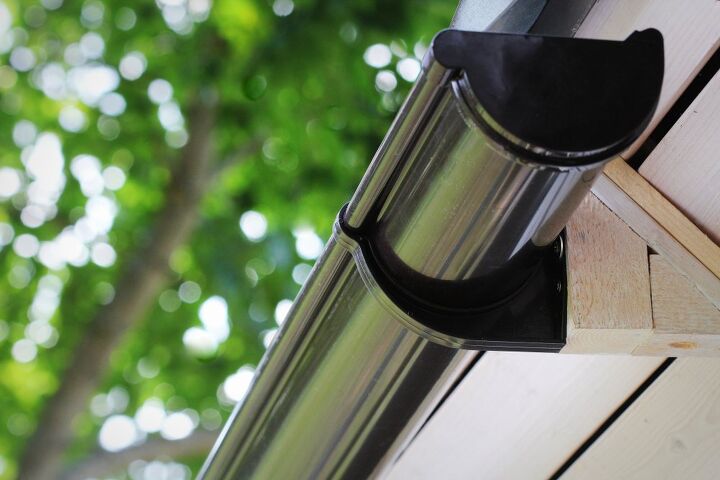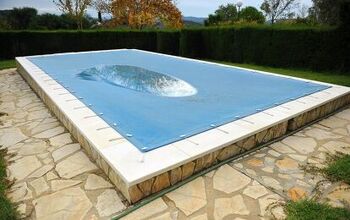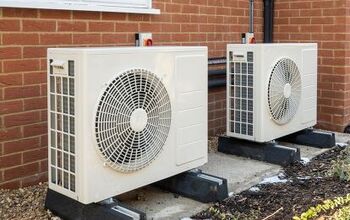What Size Gutters Do I Need? (Find Out Now!)

While a specific shape and size may come to mind when you think about gutters, they are actually available in numerous shapes and sizes. Gutters are more diverse than many assume, and understanding your options can help you decide which gutter product is the ideal fit for your home. So, this brings us to the question that is likely on your mind: “What size gutters do I need?”
The answer to this question usually stems from the type of gutter system you are installing on your home and the size of your roof. Although five-inch K-style gutters and six-inch half-rounds are the most common residential sizes, homes that are prone to heavy downpours or those with large, steep roofs may require wider gutters or additional downspouts.
With that said, let’s take a deeper look at gutter sizes and the steps involved in calculating how large the gutters on your home need to be.
Related Guide: 5-Inch Gutters vs. 6-Inch Gutters
Do You Need Roofing, Siding, or Gutter Installers?
Get free, zero-commitment quotes from pro contractors near you.

Standard Gutter Sizes
When it comes time to replace your gutters, it’s crucial to understand that gutters come in many sizes. They may be four, five, or six inches, while downspouts range in size as well, such as two inches by three inches and three inches by four inches. In most cases, either six-inch half-round gutters or five-inch K style gutters will be used on a residential home.
However, homes that are located in areas that experience heavy rainfall will generally require wider gutters and extra downspouts to accommodate and also prevent overflowing. The same is the case for houses with large, steep roofs. So, how do you know what gutter size you need?
What Size Gutters Do I Need?
To determine the size gutters that your home needs, you first need to calculate the square footage of the drainage area. In other words, you need to figure out how much water is going on your roof and then flowing into your gutters. Generally speaking, the larger the roof, the more water that will travel into the gutter system.
For a basic gable-end roof, calculating square footage only involves two calculations – one for each slope. With hip roofs or intersecting roofs, there are much more factors at play. In these cases, you’ll need to calculate the area (length x width) of each surface within a drainage area and add them all up to get the total square footage.
How to Calculate Gutter Size
Considering Pitch and Rainfall
Once you find out the total square footage of drainage for each gutter, you should make adjustments for the following:
1. Roof Pitch & Pitch FactorOverall, the steeper your roof’s pitch, the larger the gutter you’ll need. This has to do with the fact that steeper roofs will collect more windblown rain. Your roof acts like a waterslide, with water sliding quickly into your gutter when there is a steep pitch. This makes it very easy for your gutter capacity to get overwhelmed.
You can measure your roof’s pitch by using a two-foot level and a tape measure. Simply hold one end of the level against your roof’s edge and level it. Then, start at the midpoint of the level and measure the distance to the start of the roof. You’re essentially determining the short side of a triangle. The number that you get is your roof pitch.
If the number ends up being three inches or less, you do not have to add any extra capacity for roof pitch, as your roof is relatively level. However, if the number is 12 inches or more, you’ll have to multiply the square footage of the roof by 1.3.
Once you find out the pitch of your roof, use the numbers below to determine your roof-pitch factor:
- Four inches: multiply drainage area by 1.05
- Six inches: multiply drainage area by 1.1
- Nine inches: multiply drainage area by 1.2
- 12 inches or more: multiply drainage area by 1.3
These numbers are helpful, as an exceptionally steep roof means that rainwater will flow faster and can overload poorly sized gutters. Whereas, a flat or minimally-sloped roof will run slower and will generally need a much smaller gutter. For best results, it’s advised that your work with a professional who will understand the climate in your area and also the size of gutter that is ideal for the roof you have.
2. Maximum Rainfall IntensityIn addition to roof pitch, you also want to consider the intensity of the rainfall in your area when determining gutter size. The National Weather Service publishes their Precipitation Frequency Data Server (PFDS), which is helpful in finding out precipitation frequency estimates for a particular state and region.
You can also use rainfall maps provided by the National Weather Service in order to determine rainfall totals in your area. Regardless, the higher the amount, the larger the gutter should be in order to prevent the system from becoming overwhelmed during heavy downpours.
Consider Your Gutter Shape Options
In addition to knowing how much and how quickly water is coming off of your roof, you must consider the shape of gutter you want to use on your home. Different types of gutters can contain different amounts of water at one time.
Half-Round Gutters
As the name indicates, half-round gutters essentially look like a tube that has been cut in half and have a symmetrical U-shape. In most cases, these gutters are used on older, historic homes. Though, they can work well with modern homes that are meant to be less angular than the standard.
Half-round gutters tend to not move as much and have a smoother interior than K-style gutters. The latter helps enhance the gutter’s durability and also prevents corrosion of the metal over time. With a smooth inside, half round gutters tend to be more effective at washing debris out of the gutter system. As such, they usually require less maintenance and do not leak as often as their K-style counterparts.
After you determine your roof’s square footage, you can choose the size half-round gutter you need:
- Five-inch half-round gutters for roof areas under 2,500 square feet.
- Six-inch half-round gutters for roof around between 2,500 and 3,840 square feet.
With this in mind, it’s important to consider the small capacity of half-round gutters. While you may love the look of this style of gutter, it’s easy for them to get overwhelmed, which can lead to serious problems. When in doubt, always opt for the next biggest size.
K-Style Gutters
K-style gutters get their name from the profile of the gutter when viewed from the side. The outer shape of this type of gutter roughly represents the letter K, unlike the rounded, half-circle shape of half-round gutters. They are the most widely-used gutter type in the United States, somewhat resembling stylish crown model used on interior ceilings. Because of their unique shape, K-style gutters are less likely to protrude or bend when impacted by force. This makes them stronger, even though they are made of lightweight materials like aluminum.
Five-inch and six-inch are the most common sizes for K-style gutters, especially for residential properties. Anything larger than six inches is usually reserved for churches and commercial buildings. When compared to half-round gutters, K-style can accommodate almost double the amount of water. Below we’ve outlined the recommended K-style gutter size, based on the square footage of your roof area:
- Five-inch K-style gutters for roof areas under 5,500 square feet.
- Six-inch K-style gutters for roof areas between 5,500 and 7,900 square feet.
In both instances, a three-inch by four-inch downspout is ideal. For areas that see heavy downpours, you may need to go up to seven or eight inches for either half-round or K-style gutter systems. However, you likely want to have these installed by a professional, as these larger sizes are usually not readily available and can be more complicated for DIY homeowners.
Do You Need Roofing, Siding, or Gutter Installers?
Get free, zero-commitment quotes from pro contractors near you.

Additional Capacity
When your runoff will not accommodate standard-sized gutters, you have three main options:
1. Size up to seven- or eight-inch gutters
Again, they will require professional installation, a custom order, and will generally cost more than standard sizes.
2. Raise the pitch of the gutter
About ¼ inch per ten feet is the standard pitch. By increasing the pitch, you will enhance the gutter’s handling capacity. Though, the gutter may look slightly askew over the long term.
3. Add downspouts
All of the recommendations outlined above assume that you have downspouts installed every 40 feet that are properly sized. Like gutters, the capacity of your downspouts must either match or exceed the anticipated runoff.
The chart below outlines the additional downspouts your home may need to accommodate the higher runoff. For example, simply adding an extra two-inch by three-inch rectangular downspout will increase your gutter’s capacity by 600 square feet of drainage area.
Rectangular Downspouts
- Two-inches by three-inches: 600 square feet of drainage area
- Three-inches by four-inches: 1,200 square feet of drainage area
Round Downspouts
- Three inches: 706 square feet of drainage area
- Four inches: 1,255 square feet of drainage area
In addition to properly sizing gutters, increasing pitch, and adding downspouts, you can also install gutter guards. This will help keep your gutter system free of debris and flowing as efficient as possible.
Related Guide

Jessica considers herself a home improvement and design enthusiast. She grew up surrounded by constant home improvement projects and owes most of what she knows to helping her dad renovate her childhood home. Being a Los Angeles resident, Jessica spends a lot of her time looking for her next DIY project and sharing her love for home design.
More by Jessica Stone



























